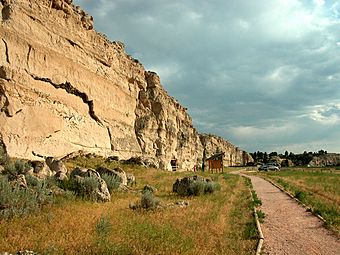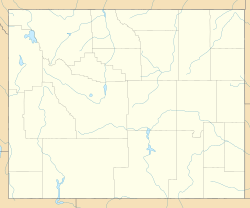Register Cliff facts for kids
Quick facts for kids |
|
|
Register Cliff
|
|

Register Cliff
|
|
| Nearest city | Guernsey, Wyoming |
|---|---|
| NRHP reference No. | 70000674 |
| Added to NRHP | April 30, 1970 |
Register Cliff is a famous sandstone cliff in Wyoming. It was a very important landmark for pioneers traveling west in the 1800s. Many travelers carved their names into the soft rock of the cliff.
This cliff was a key "checkpoint" on the Oregon Trail. It helped pioneers know they were on the right path. They needed to make sure they were heading towards South Pass. This pass was a safe way through the mountains. Register Cliff is located in eastern Wyoming, where the land starts to rise from the Great Plains towards the Continental Divide.
Hundreds of thousands of people used trails like the Oregon Trail. They traveled west to find new homes and opportunities. Many of them followed a custom of carving their names into the rocks. This is why it's called "Register Cliff." Other trails, like the California Trail and Mormon Trail, also branched off from this main route further west. From 1843 to 1869, about 500,000 pioneers used these trails. The journey was very difficult, and many people faced great dangers.
Register Cliff is the first of three main "recording areas" in Wyoming. The other two famous spots are Independence Rock and Names Hill.
In 1969, Register Cliff was added to the National Register of Historic Places. This means it is an important historical site that needs to be protected.
Pioneers often camped at Register Cliff on their first night after leaving Fort Laramie. A man named Henry Frederick later donated the land to the state of Wyoming. This was done to make sure the cliff would be preserved for future generations.
What Is Register Cliff Made Of?
Register Cliff is a tall wall of soft, chalky limestone. It rises more than 100 feet (about 30 meters) above the North Platte River.
The cliff is made of flat layers of rock. These layers were slowly worn away by the river over a very long time. Flat, grassy plains stretch from the bottom of the cliff all the way to the river. Water was the main force that shaped the cliff. Today, wind and rain continue to change its features, but not very much.
Images for kids





